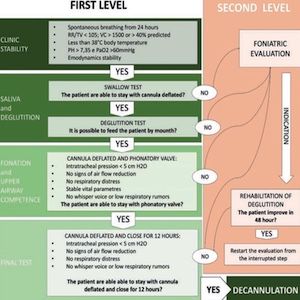How the work of respiratory physiotherapists changes the tracheostomy management and decannulation in a NICU department: an Italian experience

All claims expressed in this article are solely those of the authors and do not necessarily represent those of their affiliated organizations, or those of the publisher, the editors and the reviewers. Any product that may be evaluated in this article or claim that may be made by its manufacturer is not guaranteed or endorsed by the publisher.
Authors
Tracheotomy is a clinical procedure that is often necessary though not without complications, hence the need for appropriate and timely decannulation. The inclusion of trained respiratory physiotherapists (RPT) in the staff and the use of shared protocols could help the team to manage the patient with tracheotomy cannula. The objective of this study was to describe the difference in the rate of decannulation and clinical outcomes of tracheostomized patients admitted to a NeuroIntensive Care Unit (NICU) team after the inclusion of a group of physiotherapists specialized in respiratory physiotherapy and a new phoniatric protocol. It is a 6-year retrospective study, in which two periods of 3 years each were compared: in the first period (P1: September 2013-August 2016) physiotherapists were called to treat NICU patients on a consultative basis (2 hours/day for 5 days a week); in the second period (P2: September 2016-August 2019) two full-time respiratory physiotherapists were present on the ward (7 hours/day, 6/7 days/week). In P2 period, a decannulation protocol was used. Patients who had undergone a tracheotomy procedure and who were alive at the time of discharge were retrospectively evaluated. We described the number of decannulations, the length of stay in NICU and decannulation time; the diagnosis of decannulated patients and the number of deaths. 928 total patients were analysed: 468 in P1, 460 in P2. Total length of stay or number of deaths did not change significantly between the two periods, while the number of decannulated patients before the discharge was higher in P2 143 (64%), compared with P1 79 (36%) p<0.001. More patients with neurological pathologies involving possible swallowing disorders, such as cerebral haemorrhage, head trauma and stroke, have been successfully decannulated in P2 than in P1 (120 patients in P2 vs 54 in P1). A multidisciplinary approach, including respiratory physiotherapist, dedicated to tracheostomy management, decannulation and early mobilization in NICU is safe, feasible and seems to improve the number of severe patients decannulated, even if no change was observed in NICU length of stay or deaths. Further studies must confirm our results in other ICU settings.
How to Cite

This work is licensed under a Creative Commons Attribution-NonCommercial 4.0 International License.






